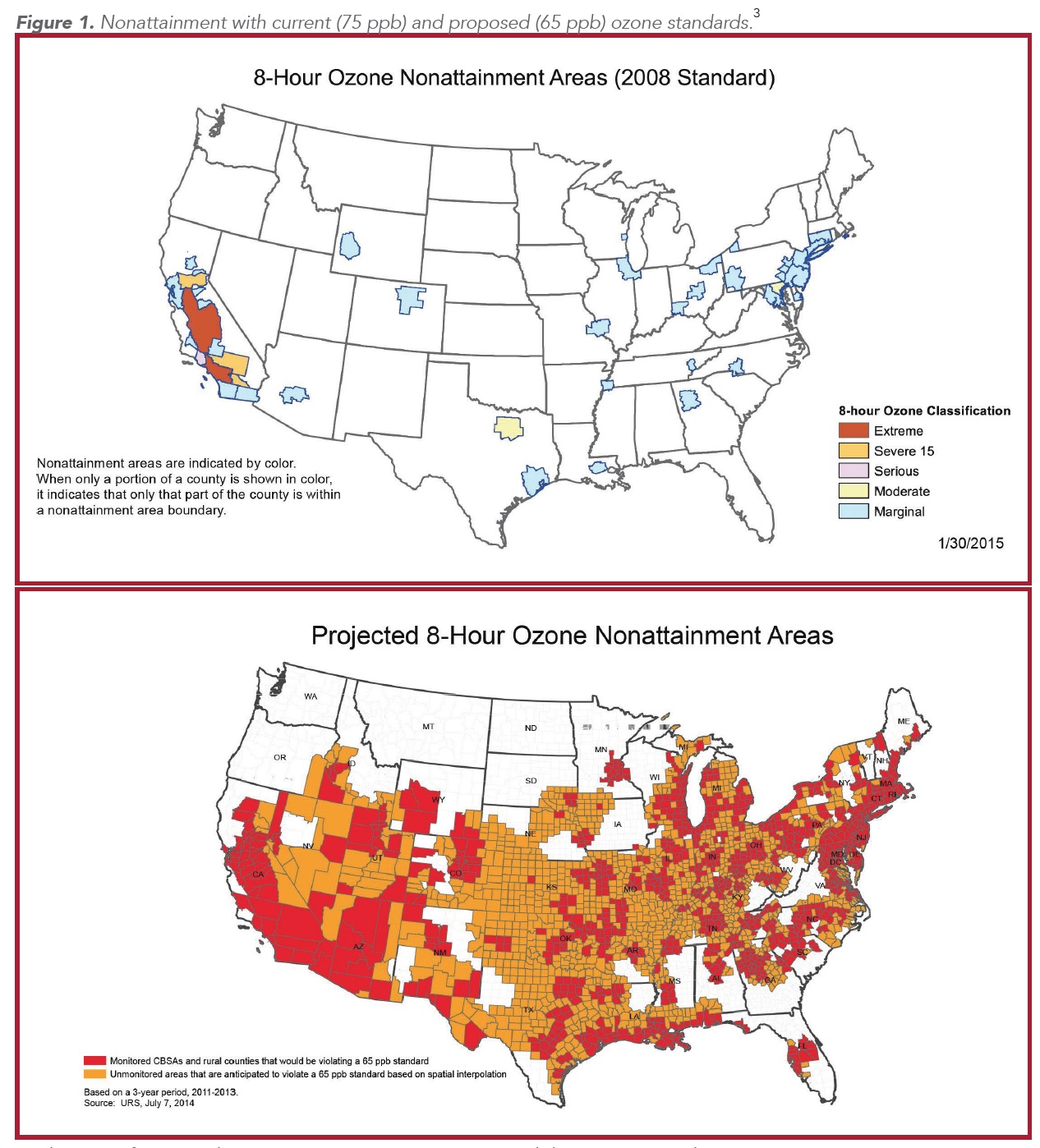UNITED STATES CHAMBER OF COMMERCE
Grinding to a Halt: Examining the Impacts of New Ozone Regulations on Key Transportation Projects
Introduction & Executive Summary
America’s transportation system is in dire need of repair. From coast to coast, urban and rural areas alike face deteriorating roads and transit systems, both hobbled by growing congestion and an increasingly limited ability to meet infrastructure needs that are literally the foundation of economic development and job growth.
Nearly 20 percent of America’s major roads are in poor condition. Vehicle repairs and extra operating expenses due to inadequate roads cost U.S. motorists $109 billion per year— equivalent to $516 per motorist. Population growth and increased travel have resulted in congestion on 44 percent of major urban highways, costing motorists $121 billion each year in wasted time and fuel costs. Similarly, many metropolitan areas face growing public transit challenges, from the maintenance and operation of existing systems to the construction of new capacity to accommodate increased ridership and demands for expanded service.
Meanwhile, state and local governments are scrambling to do more with less, as declining funding and Congressional inaction on needed reforms leaves few options beyond transportation triage. For these reasons and more, the U.S. Chamber of Commerce has made securing long-term policy changes and funding certainty necessary to address transportation challenges a top priority.
As Congress gears up to debate reauthorization of surface transportation programs, this report is intended to call attention to a significant emerging threat to addressing the aforementioned transportation challenges: the Environmental Protection Agency’s (EPA) forthcoming ozone national ambient air quality standards (NAAQS). This report analyzes the impact of these regulations on transportation projects, with a focus on the Washington, D.C. metropolitan area.
Expected to be finalized later this year, the rules threaten to hit nearly every sector and region of the economy. The stringent level at which EPA has proposed to tighten the ozone standard will result in unprecedented compliance costs and challenges, and many states and metropolitan areas have said that meeting the proposed standard will be extremely difficult, if not impossible.
State and local governments unable to develop satisfactory compliance plans and demonstrate that their transportation plans meet the transportation conformity regulatory requirements—which, for reasons outlined in this report, will be increasingly difficult—face severe penalties under the Clean Air Act, not least of which is the withholding of federal transportation funding.
This analysis examines these compliance challenges and their associated potential impacts on transportation funding, with a focus on the Washington, D.C. metropolitan region. Specifically, the report details how:
- EPA’s proposed ozone regulation will dramatically increase the number of areas of the country in violation, forcing 331 counties that meet the current standard into noncompliance, and “moving the goalposts” on an additional 227 counties that have been working to comply with the agency’s 2008 standard.
- In many areas of the country, compliance will be difficult if not impossible due to a number of factors, including:
- Exceedingly limited technological options to reduce emissions. EPA itself admits that 40 percent of necessary reductions must be met by “unknown controls” currently not in existence.
- A greatly reduced ability to devise practical control strategies due to the tightened standard’s proximity to background ozone levels unaffiliated with local anthropogenic emissions.
- Growing populations and business expansion—while undoubtedly positive for local economies—exacerbate ozone compliance challenges, particularly those regions with manufacturing and industrial-based economies.
- If EPA moves forward as proposed, these challenges will combine to result in a spike in Clean Air Act noncompliance penalties, including transportation “conformity lapses” that could cause the cutoff of federal transportation. With the exception of certain exemptions, these penalties impact all highway and transit projects that receive federal funding, as well as non-federally funded projects in need of federal approvals or permits.
-
Adding insult to injury, construction delays resulting from withheld transportation funding will only worsen traffic congestion, thereby increasing ozone-forming emissions.
-
In order to avoid or resolve transportation conformity lapses, states and localities will be forced to make difficult and expensive choices, such as cancelling popular projects, taking vehicles off the road, and offsetting mobile source emissions through increased restrictions on (or shutdowns of) stationary sources such as industrial facilities and power plants.
The direct economic impacts of EPA’s proposed ozone regulations are well documented. According to the National Association of Manufacturers, the rule is expected to be the most expensive regulation in history, and will serve as an economic handcuff on business development in areas unable to comply with more stringent standards. As demonstrated in this report, however, the indirect transportation impacts of this rule could lead to similarly harsh consequences, as penalties for noncompliance result in the withholding of funds for critically important infrastructure improvements.
These cutoffs in funding and other associated impacts will serve not only to worsen the economic costs of the rulemaking, but they will also impose a literal roadblock on efforts to address the stifling congestion and critical state of disrepair of America’s roads, bridges, and transit systems in growing cities such as Washington, D.C.
Download full version (PDF): Grinding to a Halt
About the United States Chamber of Commerce
www.uschamber.com
The U.S. Chamber of Commerce is the world’s largest business federation, representing the interests of more than 3 million businesses of all sizes, sectors, and regions, as well as state and local chambers and industry associations.
Tags: Environmental Protection Agency, EPA, Ozone Regulations, U.S. Chamber of Commerce, United States Chamber of Commerce







 RSS Feed
RSS Feed